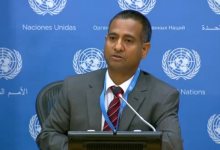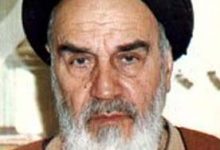Aadel Collection
Authorization Denied: the high cost of the public expression of dissent in Iran
5/31/2011 Authorization Denied: The high cost of t...
Authorization Denied: The high cost of the public expression of dissent
in Iran
July 9, 2009
1999: “There was great commotion going on at the Other recent newsletters
Shariati Hospital. God is my witness that one of the
students had a 15 centimeter wide crack in his head. Iran: In Support of the International
Many lay there with broken hands and feet. When one Campaign Against the Death Penalty
of our friends about whom we had had no news February 22, 2011
arrived, we saw that his dothes were torn into pieces,
Iran Uses the Holidays to Announce the
he bore the marks of four knife stabs on his waist,
Imminent Execution of a Student
and one side of his face was swollen and bruised.”
December 24, 2010
Iran Cannot Hide the Truth Behind
-Student's testimony on the police and militia raid of Tehran Sakineh
University dormitories, The night of July 8 to 9, 1999, in Iran December 10, 2010
the 18th of Tir.
Iran: A Reflection on the Death Penalty
and a Failed Anti-Narcotic Campaign
October 31, 2010
2009: “In the most savage attack, which occurred on
Iran's Interrupted Lives
the evening of Sunday, June 13, the forces of Ansar,
plaindothes militia, and the guards began a October 1, 2010
widespread and well-coordinated attack on the Tehran Iran's leadership guilty of crimes against
University campus. These individuals carried various humanity
weapons, induding long daggers and axes. ... They
June 8, 2010
(alsoJ set the students' living quarters on fire, and
virtually recreated another is ,' of Tir, (this timej Three Iranian human rights activists
with broader dimensions, greater filth, and brutality, receive the Lech Walesa Prize
Once again, the students' dormitories were blown up September 29, 2009
and their innocent blood was left on the walls'c
Terror in Buenos Aires : The Islamic
Republic's Forgotten Crime Against
Humanity
- Statement by the “Office for Consolidating Unity” , an July 18, 2009
umbrella organization of university Islamic associations, June
16, 2009. Neither Free Nor Fair, Elections in the
Islamic Republic of Iran
June 12, 2009
Following the June 12, 2009, presidential elections in the
Islamic Republic of Iran, a new episode of massive human Thirty Years A o in Iran
rights violations unfolded before the world. Iranian citizens February 11, 2009
took to the streets to protest peacefully against electoral >> And more...
fraud . The government responded by cutting off many
means of communication inside Iran, sequestering foreign
journalists, and giving free reign to the Bass j paramilitary Visit the Human Rights and
force and plainclothes militias to beat up and shoot at Democracy Library
protesters. The names of at least 34 victims, mostly killed International Human Rights
by gunshots in the week following the elections, have been Organizations' Reports on Human Rights
reported. The real number is believed to be higher. Abuses in Iran
Thousands ofpeacefiil citizens and activists have been
arrested, and the crackdown continues unabated. Testimonies of Victims and Perpetrators
iran rights.org/engl ish/newsletter-11.ph p 1/4
5/31/2011 Authorization Denied: The high cost of t...
of Human Rights Abuses in Iran
Students were among the first to protest these election
Iran s Pro-democracy Voices
results. They were also the first to be targeted by
government forces . On the night of June 13, forces of >> And more.. .
Ansar Hezbollah, the plainclothes militia, and security
forces raided the dormitories of Tchran University. Men's
and women's dorms were both raided. The reports on the
casualties vary, but there is at least one confirmed death ,
and scores of students were injured or anested. Similar
attacks took place in dormitories at other universities
around the country.
This is not the first time students have been punished for
expressing their views or for protesting in public. In Iran — in the
absence of legal alternatives or safe forums — domiitories have
become gathering places where cunent political and human rights-
related issues are discussed. Students are often at the forefront of
the struggle for human rights and frequently the target of state-
sponsored violence .
Ten years ago today, plainclothes militia, Ansar Hezbollah, and
security forces raided several dormitory buildings at Tehran
University to punish students who had peacefully protested on
July 8, 1999, against increasing restrictions on the press. Attackers
armed with guns, clubs, and chains targeted protesters who had
returned to their dorms, as well as students who were sleeping.
Eyewitnesses likened the attack to an earthquake —shattering
doors, windows, glass, and furniture. These material losses were
not the most serious consequence of this state-sponsored
“earthquake,” which left scores of students with broken bones,
stab wounds, and other serious injuries. The casualties were
higher in a similar attack on the dormitories of the University of
Tabriz.
Later that day, angered by what they saw as a punishment for
exercising their right to peaceful assembly, students took the
protest to the street outside the university. They were joined by
thousands of outraged Iranian citizens. The protest was violently
suppressed and, in the process, an unknown number ofprotesters
were gunned down. Among the victims was a 27-year-old pro-
demo cracy activist, Ezzat Ebrahimneiad , the only victim ever
officially acknowledged by authorities.
What followed was hardly a surprise to those who witnessed the
events of the 1980's in Iran, when revolutionary guards and
plainclothes militias attacked peaceful protests and gatherings and
caused death and injury to too many Iranian citizens to be
counted and remembered. Over the years, the Islamic Republic's
authorities have systematically denied authorization for the
peaceful gathering of dissidents; have arrested thousands of
protesters; have tortured thousands of prisoners, hoping to
extract false confessions ; and have convicted them for such
crimes as waging war against God, being agents of America, or
opposing Islam.
iran rights.org/engl ish/newsletter-11.ph p 2/4
5/31/2011 Authorization Denied: The high cost of t...
The absurd process during which victims are, thus, transformed
into perpetrators is all too familiar to Iranian dissidents and their
families. In the case of Ezzat Ebrahimnejad, the absurdity reached a
higher level. Ebrahimnejad, the victim of a fatal gunshot, was tried
and convicted , after his death, of “acts against the national
security of lran, through unlawful demonstration, engaging in
stone-throwing at the guards, and insulting the security office.”
The military court that convicted him also granted impunity to the
members and the commander of the security forces who had
attacked the University campus:
“When a demonstration disrupts or weakens the system and
insults the regime or sacred Islamic values,” explained the court,
“it cannot, by any means, be called an ordinary student protest.”
“Therefore, the security officers should have acted in
compliance with their inherent duties, in reaction to the chaos
they confronted, and it seems they did exactly that
Adding insult to injury, the court, which ordered the Treasury to
pay compensation (“blood money”) to 34 of the approximately 400
students who had filed complaints, convicted one member of the
security forces for stealing an electric razor. The justice system
failed to hold accountable those who ordered and carried out the
attack. These rulings served as a clear message to the attackers
and to their victims, confirming a long-established pattem,
repeated most recently in June 2009.
The case ofEzzat Ebrahimnejad is not exceptionaL The
fact that witnesses who saw his assailants were intimidated
and did not testiI t; that his family was threatened not to
allow students to participate in his fbneral or to follow-up
on his case; that, for years, his mother and sisters were not
allowed to mourn him in the cemetery before, after, or on
July 9, the date of his death. Rather, Ebrahimneiad's case
is representative of a consistent and ongoing pattern , meant
to erase the victims of political violence from our
memories. And it has proven successfUl.
In the absence of strong and persistent intemational solidarity,
the cost ofseeking justice has been high for students who have
ified complaints, for the lawyers who defended them and were
charged themselves, and for the hundreds of students and citizens
who have been arrested and beaten, year after year, for trying to
hold public commemorations of the July 1999 events. This time
around, in the context of the 2009 presidential election
controversy, the international community has paid more attention,
making protesters and their demands relevant. The mobilization of
civil society around the world in support of civil society in Iran
may very well help to reverse the unfortunate pattem of violence
against Iranians who struggle for a better future. But that
mobilization must be focused on issues, rooted in human rights,
and independent ofpolitics or political concems.
iran rights.org/engl ish/newsletter-11.ph p 3/4
5/31/2011 Authorization Denied: The high cost of t...
On the occasion of the tenth anniversary ofthe July 1999 events,
the Abdorrahman Boroumand Foundation (ABF) pays homage to
the memory of all the students who lost their lives, only because
they were expressing their views and exercising the right to
peacefUlly assemble. ABF reminds those responsible for these
killings that the memory of the victims will be kept alive until the
facts are revealed and justice served.
Copyright © 2011, Abdorrahman Boroumand Foundation t Back to too
iran rights.org/engl ish/newsletter-11.ph p 4/4







